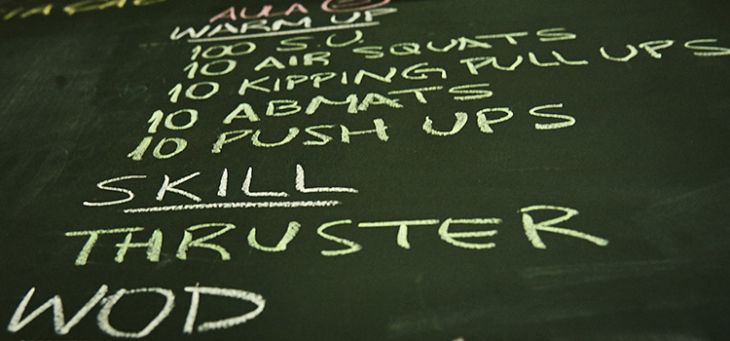As a rule, new entrants entering the CrossFit® box for the first time are a little lost when they look at the whiteboard. You recognize them immediately by the face they look at the coach as he begins to explain the WOD, without understanding half of the things said.
If you have identified yourself with this situation: do not despair. We of CrossMag we decided to explain the base, or i most used concepts, terms and abbreviations in CrossFit®, so as to help you understand the blackboard!
Index
WOD
Let's start with what you'll probably hear the most, which is WOD. This is an abbreviation of Workout of the Day, is the challenge that everyone will have to face during the lesson (and pronounces UOD ed.). WOD can be varied in many ways, it can have various movements, such as gymnastics, weightlifting, mobility, etc. The time can vary, it will be at the coach's discretion to decide the best for that day. The nice thing is that it is never the same, you can train for years without doing the same things.
Types of Wod
AMRAP
Amrap is short for as many rounds as possible, which means the as many rounds as possible. It is always followed by a number, this number indicates how many minutes you should work. For example: AMRAP 7 'you will have to perform the proposed activity for 7 minutes and count the number of rounds performed in that time frame. The score will always be the number of laps completed. We have already explored the subject, explaining theAMRAP in detail.
EMOM
Emom is short for every minute on the minute, ie every minute per minute. I mean, you have to perform an exercise and a number of repetitions in that minute. Upon completion of the repetitions, you rest the remaining time.
For example: EMOM 12 'with 10 Power Clean, it means that you will have to run 10 reps of Power Clean, inside that minute, if you finish before you rest. In the minute 2 you have to do other 10 repetitions, and rest the remaining time. So on until the end of the 12 minutes. We already have treated this training.
Tabata
Tabata is a type of training ad high intensity intervals, as for example on 4 minutes you will make 20 seconds ON and 10 OFF. At that time you have to perform the movements at maximum intensity and speed and then rest 10 seconds. This continues until the end of the 4 minutes. Read some suggestions in this interesting article on the Tabata.
Time Cap
This is another of the most listened to terms and indicates the time you have to close the WOD. On the board you will always find it along with the lesson of the day (WOD), written in various ways as CT OR TC.
If the Time Cap is 10 ', it means that you will have to close all the reps in that time frame. If you finish better first, you've done your job. Otherwise, at the end of the 10 minutes you have to stop, because the time is up and you will try to do better next time.
Heroes / Girls
These are predefined WODs, among the most difficult in existence and which honor soldiers killed in combat or women who are an example. They are the so-called benchmark wods, which are a reference for crossfitters around the world. Surely in your box you will have already heard or you will have already done one of these famous workouts that are also present in world-wide competitions.
Death by
From the name you can imagine that it's definitely not easy. Obviously it won't kill you, but it will leave you decidedly exhausted. This is a type of WOD similar to an EMOM unlike you have to do an exercise for a minute and the repetitions increase. For example, you will have to deadlift in the first minute and then rest, then 2 deadlift in the second minute and then rest, in the third minute 3 deadlift and so on until you can complete the deadlifts in a minute.
RX
Making the Wod RX is when you make the challenge exactly as it is on the board, with the suggested loads without adaptations or modifications.
Scaled
And when make changes, for example, loads to respect the blackboard. The CrossFit has many exercises that have considerable loads, so the novice ones usually fail to perform certain movements well. For this reason, the coach can suggest different weights, climbing the weights.
These are just a few CrossFit® terms that can help newcomers find their way around when they look at the board. So there are no more excuses for anyone ... If you have doubts about other terms, write in the comments that we will explain in another article!

